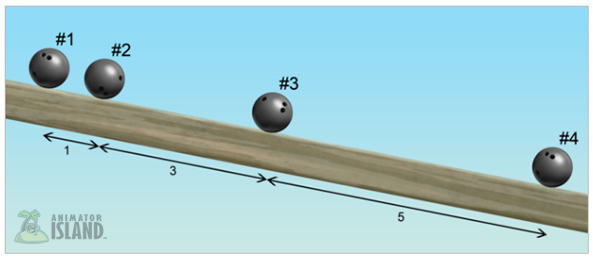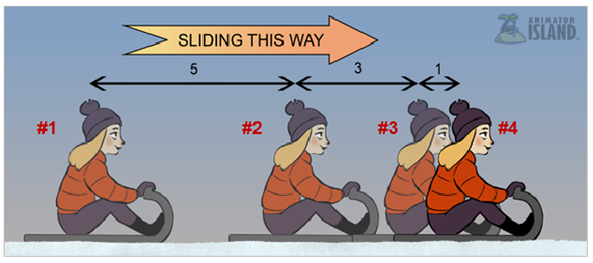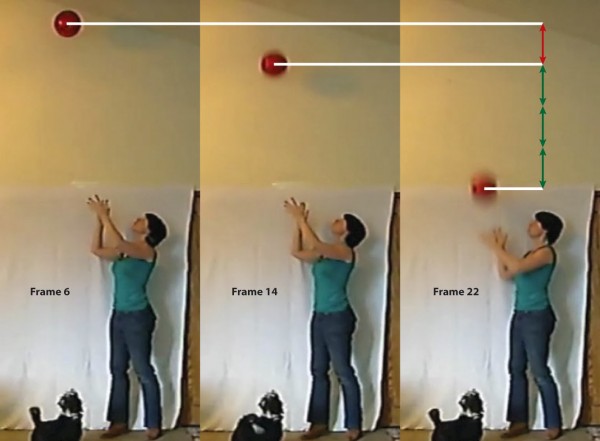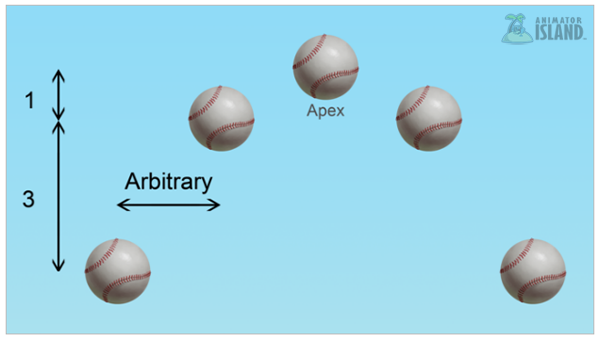Physics in Animation: Timing, Spacing, and Scale

As an animator, why do you need to know physics? After all, you’re an artist, not an engineer. Today Professor Alejandro Garcia, teacher of the course “Physics of Animation” at San Jose State, discusses the Principles of Animation Physics, and exactly what you need to know as an animator.
Chuck Jones once said, “Comparative anatomy is a vital tool of the complete animator or director.” He didn’t mean that you should learn anatomy in the same way as a medical doctor. It’s the same with physics; for an animator a basic understanding of mechanics and bio-mechanics is extremely helpful.
At San Jose State I teach Physics of Animation, a one semester course for animation artists. I have also been a physics consultant with DreamWorks Animation SKG, working on films such as Madagascar 3 and Mr. Peabody and Sherman. Animator Island has asked me to put together a few basic lessons for you and I’ve organized them following the format used by Ollie Johnston and Frank Thomas in their book, The Illusion of Life.
I’m sure that you’re familiar with Johnston and Thomas’ “Principles of Animation”, such as “Squash and Stretch”, “AnticipationPreparing a motion by first going into the opposite direction to build up momentum is called anticipation. The anticipat... More”, etc. Here is my list of the “Principles of Animation Physics” :
- Timing, SpacingSpacing is the distance an element travels between two frames of an animation. By increasing and decreasing the spacings... More, and Scale
- Law of Inertia
- Momentum and Force
- Center of Gravity
- Weight Gain and Loss
- Action-Reaction
In this first article I’ll tell you about the first principle and we’ll go into the others in future articles. But before we start, let me say one very important thing: These principles of animation physics are not for the purpose of creating physically accurate motion. They are guides to help you interpret and understand physical motion. Animators commonly use video reference, not to copy it but to extract the essence that they need. To quote Chuck Jones once more, “We must all start with the believable. That is the essence of our craft.” OK, let’s get started!
Principle #1: Timing, SpacingSpacing is the distance an element travels between two frames of an animation. By increasing and decreasing the spacings... More, and Scale
When you first learned animation you probably did the bouncing ball exercise. In that exercise you learn that timing and spacingSpacing is the distance an element travels between two frames of an animation. By increasing and decreasing the spacings... More indicate speed and that when spacings change there’s acceleration. But you probably found the timing and spacingSpacing is the distance an element travels between two frames of an animation. By increasing and decreasing the spacings... More for the ball slowing into and out of the apex by trial-and-error.
In the real world the acceleration of gravity is constant and it turns out that the ball’s spacings follow a very simple pattern. I call this pattern the “Odd Rule” because the spacings from the apex go as 1, 3, 5, 7, 9, and so on. The illustration below shows other examples of slowing out and slowing in using the Odd Rule. This is a common pattern because it appears whenever forces are constant (like gravity on Earth).


The Odd Rule is helpful for animating straight aheadWhen animating straight ahead, the animator draws one frame of the animation after another in order. Because the motion ... More action but for pose-to-pose animation there’s a useful variant that I call “Fourth Down at Half Time.” The rule is also very simple: the position of the breakdownA breakdown is a pose at the turning point of a motion path - often during the fastest moment of a motion. It's often se... More pose, between the apex and the final pose, is a quarter of the distance from the apex; the video screenshots below demonstrate this rule. Shoot some reference and check it yourself!

When there’s no acceleration the velocity is constant so the speed is constant. For an object or character flying through the air that means that the horizontal spacings stay constant while the vertical spacings follow the Odd Rule and Fourth Down at Half Time. This leads to a path of action that’s a parabolic arc, as seen in the illustration below. By the way, while the horizontal spacings are arbitrary all falling motion has the same timing (i.e., the acceleration of gravity is the same for all objects).

The Odd Rule and Fourth Down at Half Time tell you about spacingSpacing is the distance an element travels between two frames of an animation. By increasing and decreasing the spacings... More but what about timing? It takes a ball about ½ second to fall to the ground from a height of 4 feet (120 centimeters). Our rules tell us that in ¼ second it only falls a distance of 1 foot (30 centimeters) and if it falls for 1 second then, from its apex, it travels a distance of 16 feet (almost 5 meters).
These numerical calculations are rarely useful to character animators but I’m mentioning them because of the importance of timing in creating scale. Suppose that a character jumps off the roof of a house and lands on the ground in a ½ second (12 frames at 24 fps). The character will feel small because this timing indicates that the house is four feet tall. This applies not just for falling motion but also swinging, walking, running, etc. since timing of the arms and legs has a similar scaling. Timing has a huge effect on creating a sense of scale; just a 20% change in the timing will make a 6 foot character seem like it’s only about 4 feet tall. Try this with some of your own work; play with the timing to see how it affects the scale.
[the_ad_placement id=”ad-in-article”]
That’s all for now. Look for future articles covering the other Principles of Animation Physics appearing here on Animator Island. See you then!
You can check out the recent interview with Mr. Garcia right here as well.
[author] [author_image timthumb=’on’]https://www.animatorisland.com/wp-content/uploads/2011/10/AlejandroGarcia.png[/author_image] [author_info]Professor Alejandro Garcia has taught Physics of Animation at San Jose State since 2009. In 2011 he spent a one-year professional leave as physicist-in-residence at Dreamworks Animation SKG.
Find out more about Animation Physics on his website Animationphysics.org or his YouTube Channel[/author_info] [/author]






This is very impressive! When will the next one be up online? I can’t wait!
Hey Theresa!
The next installment should appear sometime in January. We’ll be off for the holidays, and regular updates will resume then! Glad you enjoyed the article. 🙂
Great one, thanks. I look forward to hearing the other new principals. 😀
Hi.what is this,im find out for teach ,thermodiamics .please help me
Just wanted to say that even these articles that are a few years old, will ALWAYS still be useful to animators. It certainly was to me!
Keep up the good work Animator Island!